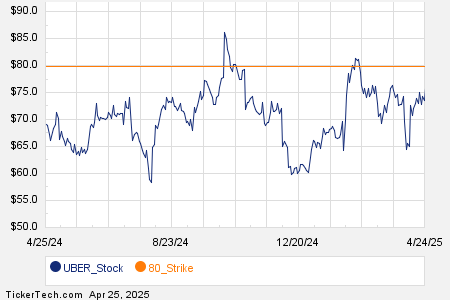Cloud Champions: Amazon vs. Microsoft in 2024
Both Amazon (NASDAQ: AMZN) and Microsoft (NASDAQ: MSFT) experienced notable growth in their cloud-computing divisions in 2024. While Microsoft’s Azure led in revenue growth, Amazon’s stock outperformed overall this year. Let’s examine which stock could deliver bigger gains moving forward.
Where to invest $1,000 right now? Our analyst team has revealed their picks for the 10 best stocks to buy today. See the 10 stocks »
Growth in Cloud Computing
Cloud computing has emerged as a major growth area, driven by the rise of artificial intelligence (AI). Companies use cloud services from firms like Amazon and Microsoft to develop their own AI models and applications.
Amazon pioneered the cloud-computing industry in 2006 with the launch of Amazon Web Services (AWS), transforming how infrastructure is developed for partners and affiliates. Today, AWS stands as Amazon’s most lucrative segment, with a trailing 12-month operating income of $36.4 billion, surpassing the $24.3 billion from Amazon’s North American and international retail operations combined.
Presently, Amazon holds about a 31% market share in the cloud sector, significantly ahead of Microsoft Azure at 20%. Last quarter, AWS’s revenue rose by 19%, while its operating income soared by 49%, driven in part by the AI-related revenue growth of over 100%.
Amazon capitalizes on AI in AWS through services like Bedrock and SageMaker. Bedrock provides foundational AI models from various companies, including Meta Platforms and Anthropic. SageMaker assists clients in building and training their AI models for production.
Additionally, Amazon has developed custom AI chips like Graviton and Trainium for training large language models and inference. Companies such as Apple, Anthropic, and SAP utilize these chips.
On the other hand, Azure has emerged as one of Microsoft’s fastest-growing sectors, with revenues jumping 33% last quarter. Benefiting from demand, Azure’s OpenAI usage doubled as customers transitioned their apps from testing to production. Furthermore, Azure AI has boosted the use of its data and analytics services, such as Azure Cosmos DB and Azure SQL DB.
However, Microsoft’s growth is being limited by capacity issues as it invests in expanding AI infrastructure to meet demand. The company projects Azure revenue to rise between 31% and 32% in constant currency for the upcoming fiscal quarter and to accelerate in the latter half of the fiscal year as it fulfills prior capital expenditures.
Expanding Beyond Cloud Services
Both Amazon and Microsoft offer more than just cloud solutions. Amazon remains the largest e-commerce and logistics firm globally and operates the Prime Video streaming service.
In retail, Amazon’s North American sales increased by 9% last quarter, with international sales rising by 12%. The company employs AI and robotics to enhance efficiency in warehouses and logistics.
Moreover, Amazon’s sponsored ad business is flourishing, leading to operating income growth significantly surpassing revenue gains. The North American segment saw operating income rise by 33% to $5.7 billion, with the international segment reporting $1.3 billion in operating income compared to a loss the previous year.
Microsoft continues to dominate workplace productivity with its Office 365 suite, featuring popular tools like Word, Excel, and PowerPoint. Its Windows operating system remains a significant revenue generator. The company also owns LinkedIn, Xbox, GitHub, and several other businesses.
The potential for growth is substantial, particularly with Microsoft’s Copilot 365 AI agents. These AI assistants have advanced capabilities, including using Python in Excel through natural language commands. At $30 per enterprise user monthly, combined with a 365 subscription, this presents a notable revenue opportunity for the future.

Image source: Getty Images.
Evaluating Valuation and Making a Choice
In terms of forward valuations, it’s important to note that Microsoft and Amazon operate on different fiscal years. Currently, Amazon trades at a forward price-to-earnings (P/E) ratio just under 36 times expected earnings for the year ending December 2025. Meanwhile, Microsoft trades at just under 32.5 times its expected earnings ending June 2025, making it the cheaper option. Moreover, Microsoft’s revenue growth outpaced Amazon’s, at 16% last quarter compared to 11%.
Looking ahead to 2025, I hold a favorable view of both stocks, anticipating they will continually be strong performers. However, based on its lower valuation, faster revenue growth, and significant potential in AI, I have a slight preference for Microsoft in the coming year.
A Second Chance at Investment Opportunities
Have you ever felt like you missed out on investing in top-performing stocks? Here’s your chance to catch up.
Our analysts occasionally issue a “Double Down” stock recommendation for companies they believe are poised for growth. If you worry about missing your chance, now is the ideal time to consider investing.
- Nvidia: $1,000 invested back in 2009 would now be worth $348,216!*
- Apple: A $1,000 investment from 2008 would be worth $47,425!*
- Netflix: If you invested $1,000 when we doubled down in 2004, you’d have $480,681!*
Currently, we’re issuing “Double Down” alerts for three promising companies, and this opportunity may not last long.
See 3 “Double Down” stocks »
*Stock Advisor returns as of December 30, 2024
John Mackey, former CEO of Whole Foods Market, an Amazon subsidiary, is a member of The Motley Fool’s board of directors. Randi Zuckerberg, a former director of market development and spokeswoman for Facebook and sister to Meta Platforms CEO Mark Zuckerberg, is also on the board. Geoffrey Seiler has no position in any of the stocks mentioned. The Motley Fool has positions in and recommends Amazon, Apple, Meta Platforms, and Microsoft. The Motley Fool recommends the following options: long January 2026 $395 calls on Microsoft and short January 2026 $405 calls on Microsoft. The Motley Fool has a disclosure policy.
The views and opinions expressed herein are those of the author and do not necessarily reflect those of Nasdaq, Inc.


